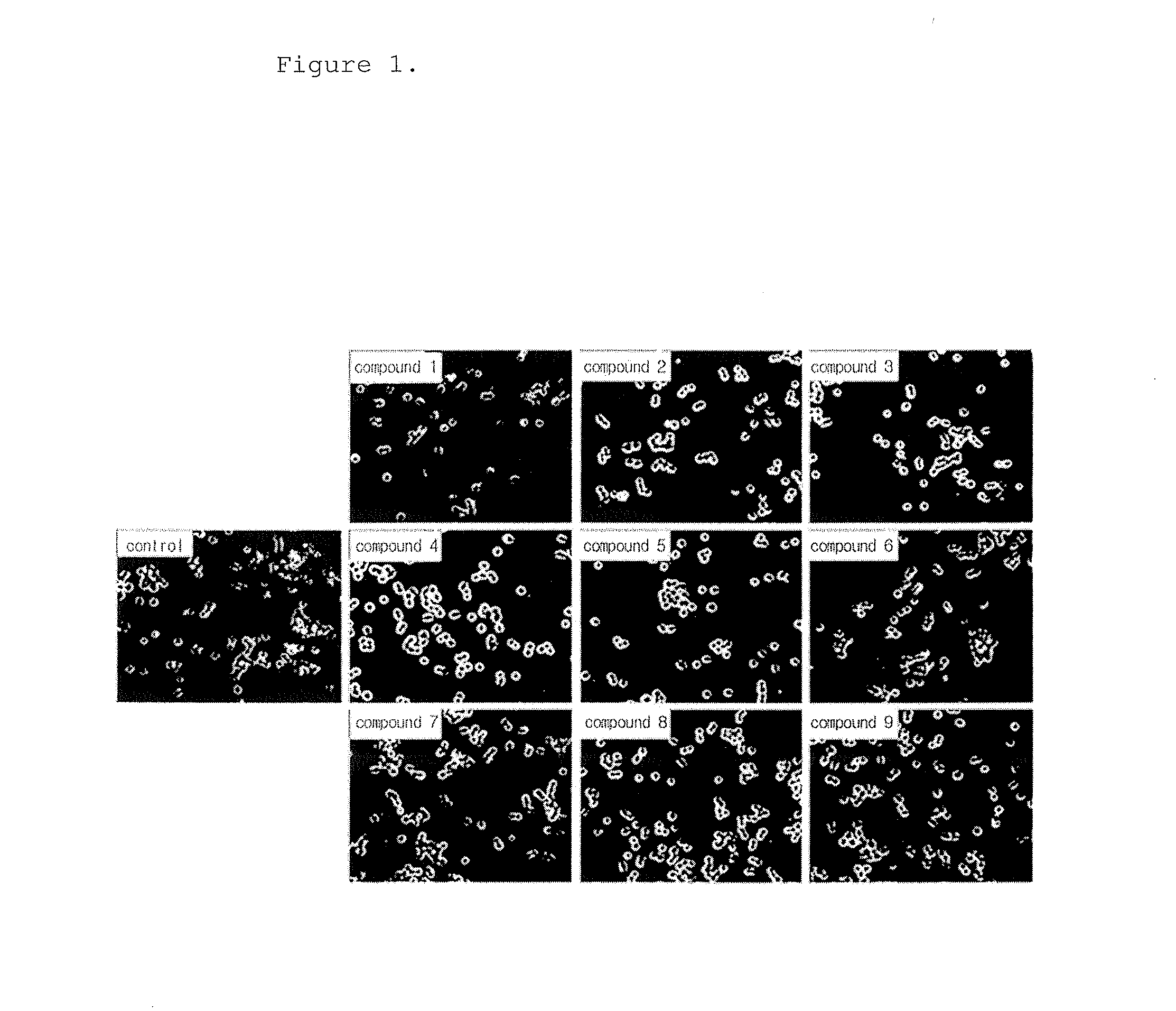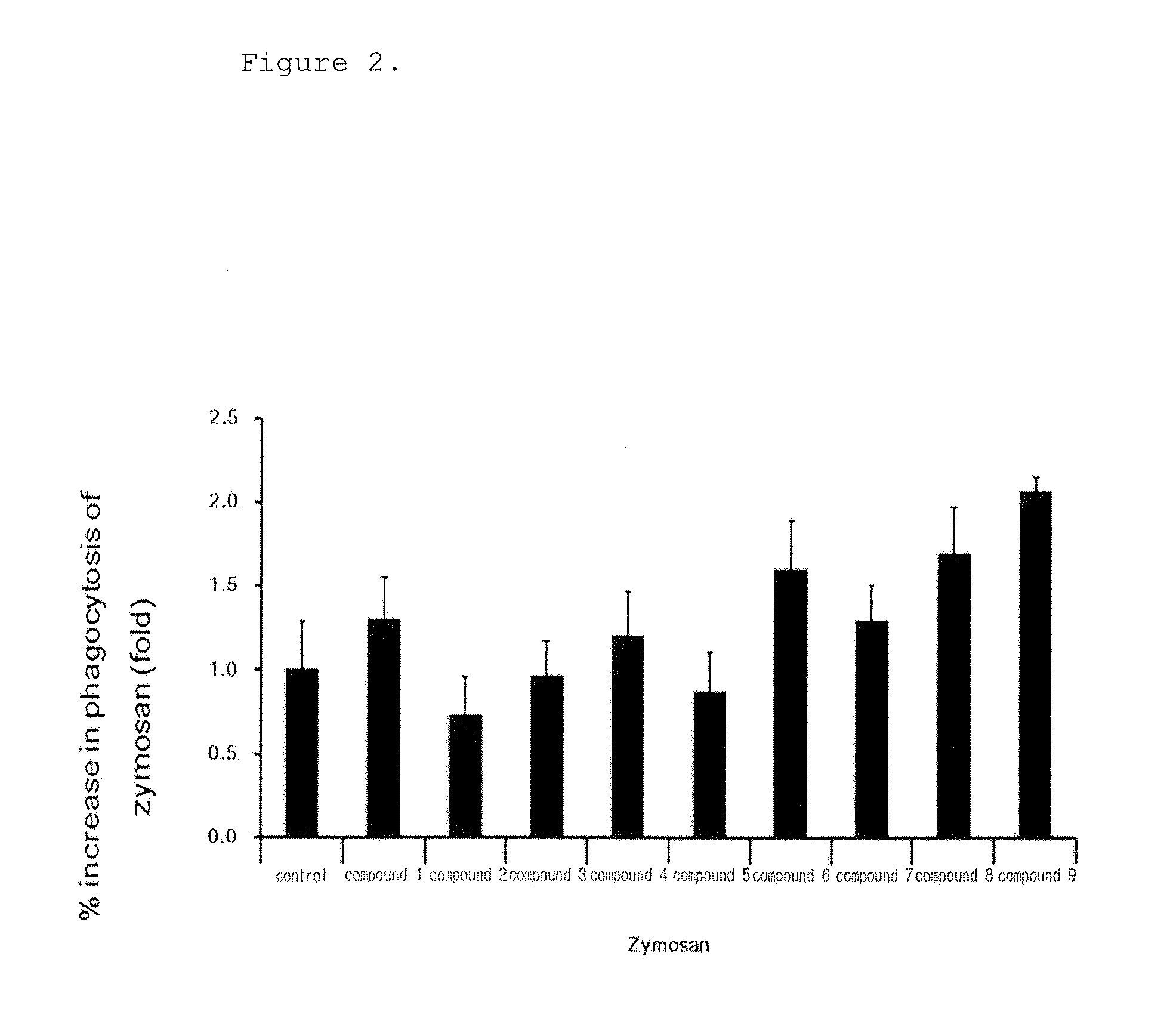Novel biphenyl derivative or pharmaceutically acceptable salt thereof, and pharmaceutical composition for preventing or treating inflammatory diseases or autoimmune diseases comprising the same as active ingredient
- Summary
- Abstract
- Description
- Claims
- Application Information
AI Technical Summary
Benefits of technology
Problems solved by technology
Method used
Image
Examples
example 1
Preparation of Novel Biphenyl Derivatives
1-1. Preparation of methyl-2-bromobenzoate
[0065]
[0066]2-bromobenzoic acid (o-isomer) (3.25 g, 15.25 mmol) was added to methanol (50 ml) and cooled in ice, and then thionyl chloride (5.41 ml, 74.58 mmol) was slowly added for about 15 minutes. After removing the ice, the mixture was stirred at 90° C. for 4 hours. The mixture was cooled at room temperature, filtered, concentrated, and then purified by silica gel column chromatography (EtOAc:hexanes=1:9), yielding methyl-2-bromobenzoate as a colorless oil (5.08 g, 95% yield).
[0067]Moreover, methyl-3-bromobenzoate or methyl-4-bromobenzoate was obtained by the above method using isomer 3-bromobenzoic acid (m-isomer) or 4-bromobenzoic acid (p-isomer) which was different from 2-bromobenzoic acid.
[0068]The obtained compounds were characterized by 1H-NMR, and the results are as follows:
[0069]Methyl-2-bromobenzoate: 1H-NMR (DMSO-d6, 500 MHz) δ 7.94 (1H, m, aromatic-H), 7.69 (1H, m, aromatic-H), 7.59 (1H...
experimental example 1
Analysis of Phagocytosis
[0143]The following experiment was performed to analyze the phagocytosis of the novel biphenyl compounds obtained in Example 1. 5×104 RAW264.7 cells, mouse macrophages, were plated in a 24 well plate and pre-incubated in a 5% CO2 incubator at 37° C. for 18 hours. The medium was replaced with a new medium before treatment with the compounds, and the cells were treated with the compounds obtained in Example 1 at a concentration of 10 μM and incubated at 37° C. for 15 minutes. Then, the cells were treated with FITC-zymosan A (the ratio of macrophages to particle was 1:10) and incubated at 4° C. for 30 minutes such that the particles were attached to the cells. Then, the cells were washed with a serum-free culture medium to remove unattached particles and incubated at 37° C. for 30 minutes. The cells were observed under a microscope at a magnification of ×200. The phagocytosis of macrophages was determined when two or more particles were observed in macrophages, ...
experimental example 2
Analysis of Chemotaxis
[0146]The following experiment was performed using a ChemoTx 96-well chamber (Neuroprobe, Inc., Gaithersburg, Md.) to analyze the chemotaxis of the novel biphenyl compounds obtained in Example 1. HT1080 cells were suspended in an RPMI medium at a concentration of 2×105 cells / ml, and 30 ul of the suspension was added to the upper chamber. WKYMVm peptide was added to the lower chamber separated by a membrane. The cells were treated with the compounds obtained in Example 1, incubated at 37° C. for 3 hours, and stained using a Diff-Quick staining kit (Kobe, Japan). The cells were observed under a microscope and counted. The results are shown in FIG. 4.
[0147]As shown in FIG. 4, it was found that the biphenyl derivatives of the present invention inhibited the chemotaxis of macrophages.
PUM
| Property | Measurement | Unit |
|---|---|---|
| Composition | aaaaa | aaaaa |
Abstract
Description
Claims
Application Information
 Login to View More
Login to View More - R&D
- Intellectual Property
- Life Sciences
- Materials
- Tech Scout
- Unparalleled Data Quality
- Higher Quality Content
- 60% Fewer Hallucinations
Browse by: Latest US Patents, China's latest patents, Technical Efficacy Thesaurus, Application Domain, Technology Topic, Popular Technical Reports.
© 2025 PatSnap. All rights reserved.Legal|Privacy policy|Modern Slavery Act Transparency Statement|Sitemap|About US| Contact US: help@patsnap.com



